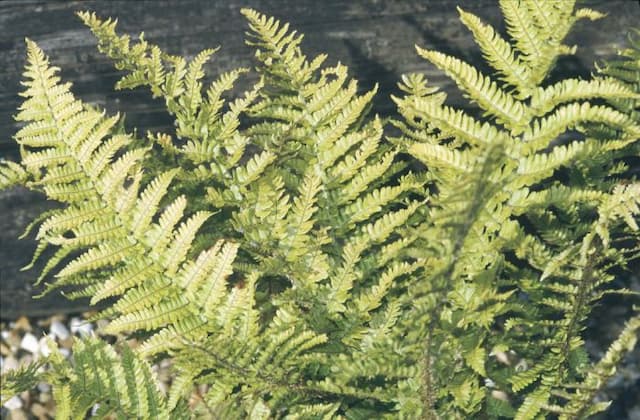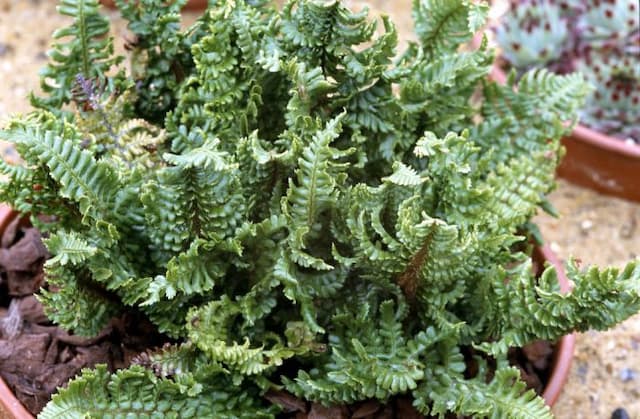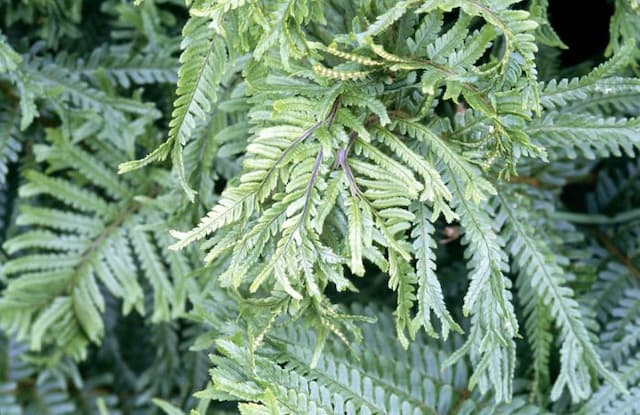Autumn Fern Dryopteris erythrosora 'Brilliance'

ABOUT
The Dryopteris erythrosora 'Brilliance', commonly known as the Autumn Fern, is a visually striking plant that exhibits a vibrant array of colors throughout its fronds. As the name 'Brilliance' suggests, this fern is celebrated for its lustrous and bright foliage. Young fronds unfurl in a striking copper-red to pink shade, providing a splash of color that resembles the hues of autumn leaves. As the fronds mature, they transition through a sequence of colors, eventually settling into a deeper green. The fern's leaves are divided into numerous leaflets, imparting a feathery texture that adds to its visual interest and elegance. The leaflets delicately line the arching fronds, giving the fern a full and lush appearance, which can add a touch of natural flamboyance to shaded garden areas or indoor spaces. Its evergreen nature ensures that it provides year-round interest, with the changing colors of the fronds marking the passing seasons. The combination of its changing palette and graceful form make the Autumn Fern a beloved addition to many gardens and indoor plant collections.
About this plant
 Names
NamesFamily
Dryopteridaceae
Synonyms
Autumn Fern, Japanese Shield Fern, Copper Shield Fern, Brilliance Autumn Fern
Common names
Dryopteris erythrosora.
 Toxicity
ToxicityTo humans
The Autumn Fern, scientifically known as Dryopteris erythrosora 'Brilliance', is generally considered non-toxic to humans. Though it is not commonly ingested, there is no widespread literature suggesting significant toxicity upon ingestion. However, as with many plants, it is always possible for individuals to experience mild discomfort, such as an upset stomach, if parts of the plant are consumed. It is advisable to keep all plants out of reach of children who might accidentally ingest them.
To pets
The Autumn Fern is not known to be toxic to pets such as cats and dogs. There are no significant symptoms of poisoning associated with the ingestion of this plant by pets. Nonetheless, it's always good practice to prevent pets from chewing on plants, as they can cause gastrointestinal irritation or other mild symptoms simply due to the ingestion of non-food items.
 Characteristics
CharacteristicsLife cycle
Perennials
Foliage type
Evergreen
Color of leaves
Mixed
Height
2 feet (60 cm)
Spread
2 feet (60 cm)
Plant type
Fern
Hardiness zones
5
Native area
Eastern Asia
Benefits
 General Benefits
General Benefits- Attractive Foliage: The 'Brilliance' variety of the Japanese Fern offers vivid, colorful fronds that emerge in shades of orange, red, and copper, providing visual interest throughout the growing season.
- Shade Tolerance: Japanese Fern thrives in shaded areas, making it an excellent choice for woodland gardens, shaded borders, or underplanting beneath larger shrubs and trees.
- Low Maintenance: It requires minimal care once established, with no need for deadheading or pruning, making it ideal for gardeners seeking a low-maintenance plant.
- Drought Resistance: After establishment, it can tolerate periods of dryness, though it prefers consistent moisture.
- Cold Hardy: This fern is resilient in colder climates, able to withstand winter temperatures without significant damage.
- Soil Adaptability: It can tolerate a range of soil types, including clay and acidic soils, as long as they are well-drained.
- Deer and Rabbit Resistance: The plant is generally resistant to grazing by deer and rabbits, which can be particularly beneficial in areas where these animals are prevalent.
 Medical Properties
Medical PropertiesThis plant is not used for medical purposes.
 Air-purifying Qualities
Air-purifying QualitiesThis plant is not specifically known for air purifying qualities.
 Other Uses
Other Uses- The fronds of the Autumn Fern can be used in flower arrangements, as they add an interesting texture and a splash of color to bouquets.
- Dried fronds of the Autumn Fern can be crafted into wreaths and garlands for rustic home decor, especially popular in the fall season.
- In terrariums or vivariums, the Autumn Fern can create a lush, tropical appearance and provides cover for small reptiles or amphibians.
- Autumn Fern's fronds can be used as a natural mulch in the garden, which can help to retain soil moisture and suppress weeds.
- As a non-toxic plant, the Autumn Fern can be safely planted in areas where pets may roam, without the worry of them ingesting harmful leaves.
- They can be used in shaded water gardens or near ponds to create a woodland feel and harmonize with the aquatic environment.
- The Autumn Fern can serve as a living skirt around the base of trees, concealing bare spots where grass might struggle to grow.
- Small fronds from the Autumn Fern can be pressed and used in craft projects, such as in handmade paper or botanical prints.
- The plant can be used in educational settings to demonstrate the life cycle of ferns, including spore propagation and growth.
- For photographers and artists, the vibrant colors of the Autumn Fern provide an excellent subject for nature-inspired artwork or photographs.
Interesting Facts
 Feng Shui
Feng ShuiThe Autumn Fern is not used in Feng Shui practice.
 Plant Symbolism
Plant Symbolism- Endurance and Longevity: As a fern, Dryopteris erythrosora 'Brilliance', commonly known as the Autumn Fern, is often associated with endurance and the ability to thrive in challenging conditions, symbolizing one's strength to persevere over time.
- New Beginnings and Hope: The unfolding of the fern's new fronds, which can have a bronze-like "brilliance" as they emerge, symbolizes new beginnings and the unfurling of fresh opportunities, conveying a sense of hope and renewal.
- Protection: Ferns in general have a long history of being associated with protection due to their dense foliage. The Autumn Fern can symbolize a shelter or refuge against difficulties, suggesting safety and security.
- Solitude and Secretiveness: Ferns are often found in shaded, secluded areas of forests, making them symbols of solitude, mystique, and the hidden aspects of nature or life.
 Water
WaterThe Autumn Fern should be watered thoroughly once a week, allowing the soil to slightly dry out between waterings. In higher heat or during dry spells, increase watering to twice a week ensuring the soil is moist but not waterlogged. Depending on the pot size, watering with about 16 to 24 ounces of water should be sufficient each time. During the winter months, reduce the watering frequency to every other week as the plant's growth slows and it requires less moisture.
 Light
LightAutumn Fern thrives in partial to full shade, making it ideal for a spot that receives filtered sunlight or dappled shade. Avoid placing it in direct sunlight as the leaves can get scorched. A north-facing window or a shaded area in a south-facing room is often a great spot for this plant.
 Temperature
TemperatureThe Autumn Fern prefers temperatures between 60 and 75 degrees Fahrenheit. It can tolerate a minimum temperature of 50 degrees Fahrenheit but avoid exposing it to temperatures below this, as it can cause damage to the plant. The fern does not thrive in temperatures above 80 degrees Fahrenheit, so keep it away from heat sources and areas that can get excessively hot during summer months.
 Pruning
PruningPruning the Autumn Fern isn't regularly necessary, but it's beneficial to remove any brown or damaged fronds to keep the plant looking tidy. The best time for pruning is in spring before new growth begins. Gently cut away the old fronds at the base without disturbing the younger, green fronds. This helps to redirect the plant's energy to new growth and can improve air circulation.
 Cleaning
CleaningAs needed
 Soil
SoilAutumn fern prefers well-draining, rich, loamy soil with a pH of 5.0 to 6.0. A mix with one part garden soil, one part peat moss, and one part perlite or pine bark is ideal for maintaining moisture while allowing excess water to drain, providing the acidity and organic matter that this fern thrives on.
 Repotting
RepottingAutumn ferns should be repotted every 2-3 years to refresh the soil and give the roots more space to grow. The best time to repot is in early spring before new growth begins.
 Humidity & Misting
Humidity & MistingAutumn ferns prefer high humidity levels, ideally between 60% to 70%. In drier environments, it is beneficial to increase humidity around the plant through misting or using a humidifier.
 Suitable locations
Suitable locationsIndoor
Place in diffused light; keep soil moist but not soggy.
Outdoor
Partial shade; protect from afternoon sun and wind.
Hardiness zone
5-9 USDA
 Life cycle
Life cycleThe Autumn Fern 'Brilliance', Dryopteris erythrosora 'Brilliance', begins life as a spore, which germinates in moist, shaded conditions to establish a small, heart-shaped gametophyte. The gametophyte produces both male and female reproductive structures and, once fertilization occurs, gives rise to a new diploid sporophyte—the leafy fern plant we recognize. This fern emerges in spring with fiddleheads that unfurl into vibrant, colorful fronds with hues of orange, copper, and red, before maturing to a deep green. Throughout the growing season, the fern increases in size and may produce new fronds from the center of the plant. As a perennial, the Autumn Fern dies back in the winter, with the fronds becoming dormant and withered, to return again the following spring from the same root system. Over years, the plant can form a large, dense clump, and it may be divided to propagate new plants and maintain vigor.
 Propogation
PropogationPropogation time
Spring-Early Summer
The popular method for propagating the Autumn Fern, scientifically known as Dryopteris erythrosora 'Brilliance', is through spores, which is best done in summer when they are ripe and ready. To propagate, one should collect fertile fronds that have ripe spore cases on their undersides and place them inside a paper bag. Allow the fronds to dry, which will cause the spores to be released into the bag. Then, the spores can be sown on the surface of a fine-textured, sterile potting mix. The potting container should be covered with plastic wrap to maintain a high humidity level and placed in a warm area with indirect sunlight. Germination takes quite a while, typically several weeks to months, and it's important to keep the soil consistently moist and to avoid direct sunlight that could scorch the tender young ferns. Once the sporelings are large enough to handle, they can be transferred to individual pots to grow on before planting out.









